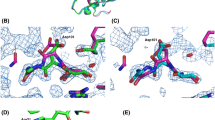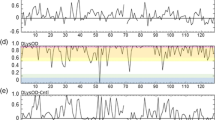Abstract
LYLA1 is a chimeric protein mainly consisting of residues originating from human lysozyme but in which the central part (Ca2+-binding site and helix C) of bovine α-lactalbumin has been inserted. The equilibrium unfolding of this hybrid protein has been examined by circular dichroism and tryptophan fluorescence techniques. The reversible denaturation process induced by temperature or by addition of chemical denaturant is three-state in the case of apo-LYLA1 and two-state in the presence of Ca2+. The Ca2+-bound form of the chimera exhibits higher stability than both wild-type lysozyme and α-lactalbumin. The stability of the apo-form, however, is intermediate between that of the parent molecules. Unfolding of apo-LYLA1 involves an intermediate state that becomes populated to a different extent under various experimental conditions. Combination of circular dichroism with bis-ANS fluorescence experiments has permitted us to characterize the acid state of LYLA1 as a molten globule. Furthermore our results strongly suggest the presence of multiple denatured states depending on external conditions.
Similar content being viewed by others
Author information
Authors and Affiliations
Additional information
Received: 24 April 1996 / Accepted: 4 September 1996
Rights and permissions
About this article
Cite this article
Dael, H., Haezebrouck, P., Pardon, E. et al. Conformational stability of LYLA1, a synthetic chimera of human lysozyme and bovine α-lactalbumin. Eur Biophys J 25, 171–179 (1997). https://doi.org/10.1007/s002490050029
Issue Date:
DOI: https://doi.org/10.1007/s002490050029




